Accepted Scientific Name: Stapelia gigantea N.E.Br.
Gard. Chron. ser. nova. 7: t. 684. f. 112. 1877

Gonostemon giganteus (Stapelia gigantea) Photo by: Valentino Vallicelli
The flowers are among the largest of the genus and can reach a diameter up to 30 cm (or more)
Origin and Habitat: Southern Africa, Zambia
Synonyms:
See all synonyms of Stapelia gigantea
back
Accepted name in llifle Database:Stapelia gigantea N.E.Br.Gard. Chron. ser. nova. 7: t. 684. f. 112. 1877Synonymy: 11
back
Common Names include:
ENGLISH: Giant Toad Plant, Giant Zulu, Star Fish Flower, Carrion Flower
RUSSIAN (Русский): Стапелия гигантская
Description: S. gigantea is a stem succulent that resembles a cactus; the branches are velvety, spineless, quadrangular in cross-section and determinate, ceasing growth when about 10 to 30 cm tall, may form big clumps up to1 m in spread.
Blooming Time: October. The inflorescence arises near the base of a branch; on this plant the inflorescence had two buds with scale-like leaves at the base of the petioles. When this flower opened., the second bud was aborted. Flowers are extremely large, soft and pulpy to the touch, star-shaped and give off a pestilent smell that attracts flies that ensure the successful pollination of this species.
The flowers have a leathery texture mimic the rotting flesh of a dead animal (like meat and fat rotting in the hot sun) and vary from pale yellow to reddish brown with an elaborate pattern of dark reddish stripes. They remember drying flesh peeling back from the bone and also fringes of soft white hairs on the corolla segments superficially resemble a layer of mold growing on rotting matter.
Bibliography: Major references and further lectures:
1) Focke Albers, Ulrich Meve “Illustrated Handbook of Succulent Plants: Asclepiadaceae: Asclepiadaceae” Volume 4 Springer, 2002
2) Gideon Smith, Neil R. Crouch “Guide to Succulents of Southern Africa” Struik Nature, 01/nov/2009
3) Focke Albers, Ulrich Meve “Illustrated Handbook of Succulent Plants: Asclepiadaceae: Asclepiadaceae” Volume 4 Springer, 2002
4) Doreen Court “Succulent Flora of Southern Africa” CRC Press, 01/giu/2000
5) Clive Innes “Complete Handbook of Cacti and Succulents” Van Nostrand Reinhold Company, 01/dic/1981
6) A.C.White & B.Sloane “Stapelieae” ( White & Sloane) ed. 2 3: 855 Abbey San Encino Press, 1937
7) Luckhoff “The Stapelieae of Southern Africa” Capetown, A.A. Balkema 1952
8) Bruyns, P.V. 2005. “Stapeliads of southern Africa and Madagascar.” Vol. II. Umdaus Press, Hatfield.
9) James Cullen, Sabina G. Knees, H. Suzanne Cubey “The European Garden Flora Flowering Plants: A Manual for the Identification of Plants Cultivated in Europe, Both Out-of-Doors and Under Glass” Cambridge University Press, 11/ago/2011
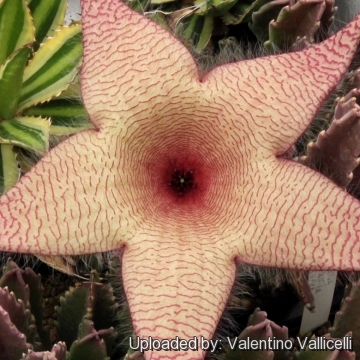 Gonostemon giganteus (Stapelia gigantea) Photo by: Valentino Vallicelli
Gonostemon giganteus (Stapelia gigantea) Photo by: Valentino Vallicelli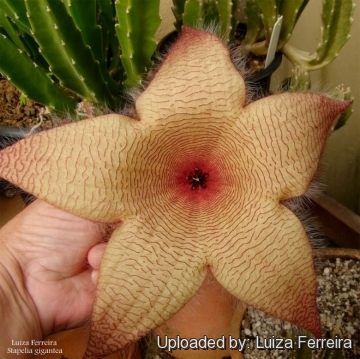 Gonostemon giganteus (Stapelia gigantea) Photo by: Luiza Ferreira
Gonostemon giganteus (Stapelia gigantea) Photo by: Luiza Ferreira Gonostemon giganteus (Stapelia gigantea) Photo by: Julio C. García
Gonostemon giganteus (Stapelia gigantea) Photo by: Julio C. García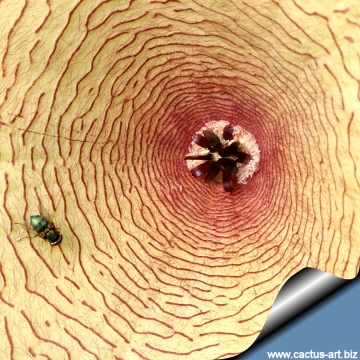 The flower mimic the rotting flesh and putrid smell of a dead animal. (Stapelia gigantea) Photo by: Cactus Art
The flower mimic the rotting flesh and putrid smell of a dead animal. (Stapelia gigantea) Photo by: Cactus Art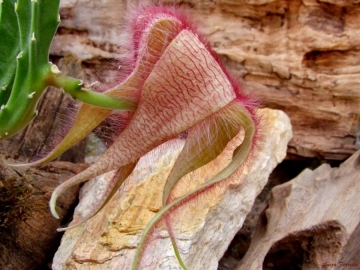 Gonostemon giganteus (Stapelia gigantea) Photo by: Luiza Ferreira
Gonostemon giganteus (Stapelia gigantea) Photo by: Luiza Ferreira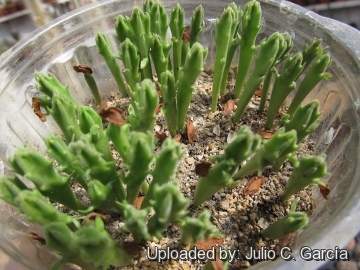 Seedlings. (Stapelia gigantea) Photo by: Julio C. García
Seedlings. (Stapelia gigantea) Photo by: Julio C. García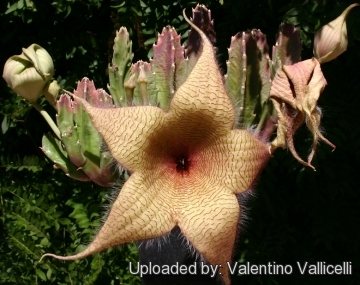 Gonostemon giganteus (Stapelia gigantea) Photo by: Valentino Vallicelli
Gonostemon giganteus (Stapelia gigantea) Photo by: Valentino Vallicelli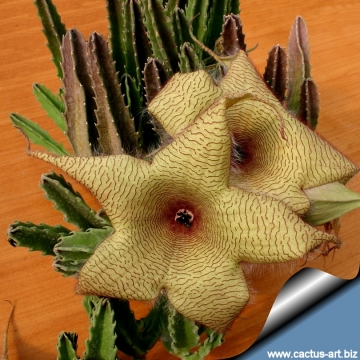 Gonostemon giganteus (Stapelia gigantea) Photo by: Cactus Art
Gonostemon giganteus (Stapelia gigantea) Photo by: Cactus ArtCultivation and Propagation: Fertilize once during the growing season with a balanced fertilizer diluted to ½ the strength recommended on the label. They need a well-drained potting-mix and can withstand extreme heat but avoid direct sun in summer. Best in partial sun or light shade.
Frost Tolerance: They need a cool, dry rest period in winter but keep above 10°C and avoid any frost.
Propagation: are propagated by stem cuttings. Take cutting in spring when new growth begins. Let cuttings callus up for 2-3 weeks before planting.
Your Photos
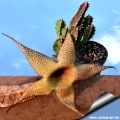
by Cactus Art

by Valentino Vallicelli




















